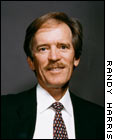NEW YORK (Money Magazine) -
Without a doubt, 2002 was a great year for Bill Gross. His Pimco Total Return fund ended the year up 9.7 percent and beat its benchmark, the Lehman Brothers aggregate bond index, for the eighth year in a row.
And last fall his $65.5 billion fund edged past the Vanguard 500 Index to become the biggest mutual fund in the country. But as the economy begins to recover, bonds will underperform stocks, says Gross. To help investors get the best possible bond returns in a more challenging environment, he's put together a model portfolio for 2003.
Q. In the past three years, bonds have had a great run as the Fed cut interest rates. Is it done cutting?
| Wall Street's take on 2003
|

|
|
|
|
A. Yes. With the Fed funds rate at 1.25 percent, we have 0 percent auto loans and 0 percent appliance loans, so I don't see what another rate cut could do. If the Fed needs to stimulate, it'll use emergency measures like buying long-term Treasuries, corporate bonds or international government bonds in an effort to depreciate the dollar, or buying stocks.
Q. So when do you think rates will rise?
 |
|
| Bill Gross, PIMCO |
A. It depends how quickly the economy picks up. When Japan raised rates several years ago from 25 basis points to 1.25 percent, they sank back into a deflationary economy. Greenspan wants to avoid that so he'll wait until the white flag for deflation is raised and then raise rates. I bet it'll happen in the fourth quarter.
Q. And that's bad news for bonds.
A. Yes, but not for all bonds. I just shifted around my own personal portfolio, moving into corporates, high-yields, emerging markets and some others. When Treasuries yield 3 percent and when rates are rising, it's not a great time to be in most Treasury bonds. Because investors shift to riskier assets, Treasuries are the first to get hurt when interest rates rise.
Q. But won't riskier bonds also get hurt when that happens?
A. All of this is predicated on the economy improving. I see moderate economic growth of 2 percent to 3 percent. In that environment, riskier bonds are OK. We're six to 12 months past the recession, and while corporate defaults are still pretty high, they should decline. And some corporates still yield 10 percent. That provides a total-return cushion if interest rates rise.
Q. So what's the ideal bond portfolio?
A. I'd put half in corporates, since the amount they yield over Treasuries is near historic highs. Corporates also tend to do well in a recovery. I like our closed-end Pimco Corporate Income fund, which trades on the New York Stock Exchange, as well as Dan Fuss'Loomis Sayles Bond fund (800-633-3330). High-yield also does well in a recovery, but I'd just put 5 percent there.
Q. And the remaining 45 percent?
A. I'd put 10 percent in a high-quality mortgage bond fund and put 5 percent in TIPS [Treasury Inflation-Protected Securities]. They protect against mild inflation -- I expect 3 percent over the next few years. TIPS yield 2.9 percent, so you get 2.9 percent plus 3 percent for a total of 5.9 percent. No matter what happens in terms of war or the deficit, both of which would bring higher inflation, you're protected.
I'd also put 10 percent in emerging markets and 20 percent in European bond funds denominated in euros. Europe's short-term interest rate is 2.75 percent, compared with our 1.25 percent, and its economy is in worse shape. Their central bank will lower rates, so their government bonds could mimic the run that bonds had in the U.S. in 2002.
Q. What return will this mix provide?
A. This portfolio will return 5 percent to 6 percent. I don't think 2003 will be the year of the bond; we just had a couple of great years. But I'm willing to concede one game in the World Series.

|

